- Back to Home »
- TWA 800 investigators stand ground
 A section of the wing of TWA Flight 800, which crashed July 17, 1996, floats in the Atlantic Ocean off Long Island, New York, on July 18, 1996. A new documentary "TWA Flight 800" claims that the explosion that caused the crash was not an accident.
A section of the wing of TWA Flight 800, which crashed July 17, 1996, floats in the Atlantic Ocean off Long Island, New York, on July 18, 1996. A new documentary "TWA Flight 800" claims that the explosion that caused the crash was not an accident. 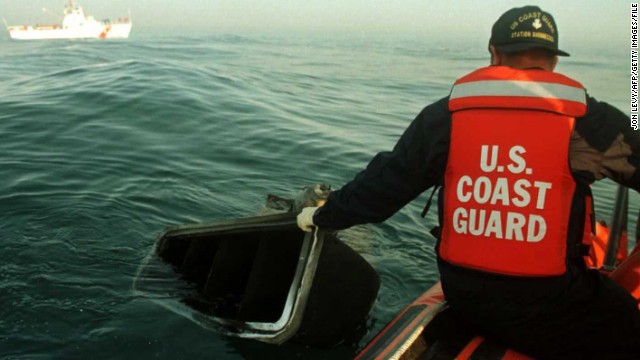 A member of the U.S. Coast Guard pulls a piece of wreckage from the waters on July 18, 1996.
A member of the U.S. Coast Guard pulls a piece of wreckage from the waters on July 18, 1996. 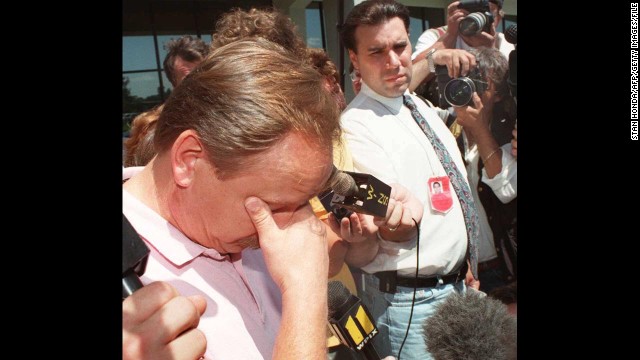 Ron Dwyer pauses to compose himself on July 20, 1996, as he speaks about his 11-year-old daughter Larkyn Lyn Dwyer, who was on TWA Flight 800.
Ron Dwyer pauses to compose himself on July 20, 1996, as he speaks about his 11-year-old daughter Larkyn Lyn Dwyer, who was on TWA Flight 800. 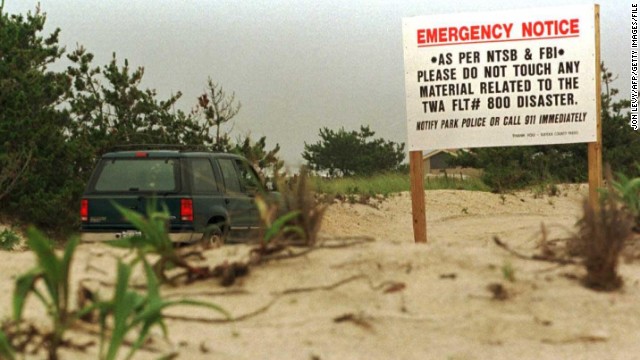 A warning sign on the dunes alerts beach-goers to watch for debris washed ashore at Smith's Point, Long Island, New York, on July 25, 1996.
A warning sign on the dunes alerts beach-goers to watch for debris washed ashore at Smith's Point, Long Island, New York, on July 25, 1996. 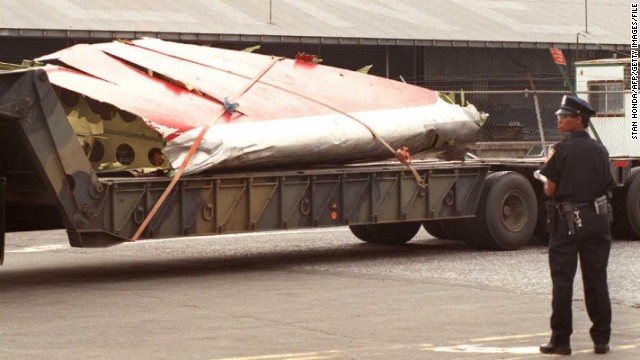 A police officer stands guard as part of the plane is transported from a dock in Brooklyn, New York, on July 19, 1996.
A police officer stands guard as part of the plane is transported from a dock in Brooklyn, New York, on July 19, 1996. 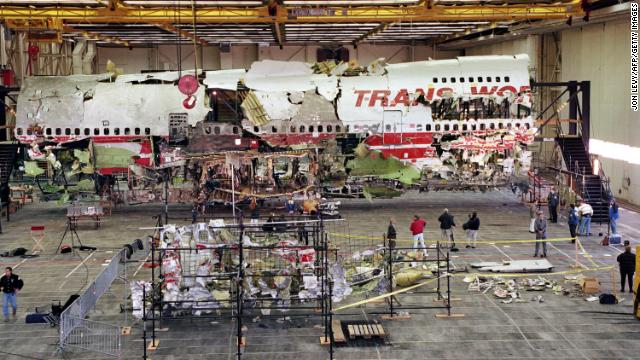 Wreckage of the front portion of the Boeing 747 aircraft is displayed in its reconstructed state on November 19, 1997 in Calverton, Long Island, New York.
Wreckage of the front portion of the Boeing 747 aircraft is displayed in its reconstructed state on November 19, 1997 in Calverton, Long Island, New York. 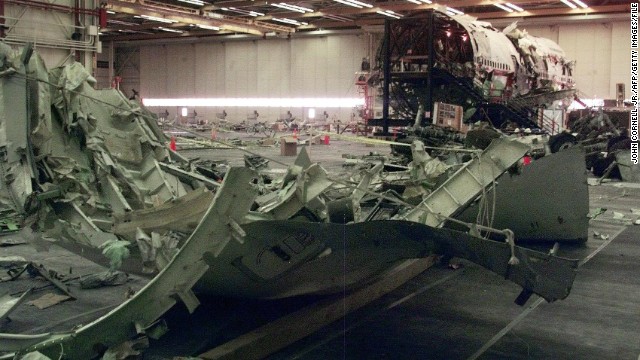 Parts of the aircraft's wing sit in the hangar on July 8, 1999, in Calverton, New York.
Parts of the aircraft's wing sit in the hangar on July 8, 1999, in Calverton, New York.  The partially reconstructed fuselage of TWA Flight 800 is pulled out of a hangar in Calverton, New York, on September 14, 1999.
The partially reconstructed fuselage of TWA Flight 800 is pulled out of a hangar in Calverton, New York, on September 14, 1999. 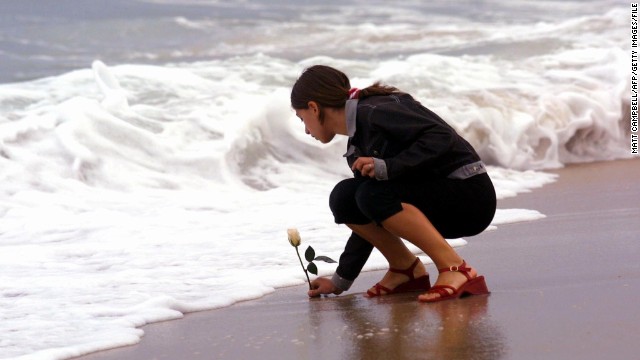 Antonella Naglieri, whose relatives Giuseppe Mercurio and Anna D'Alessandro were killed in the crash, places a rose in the surf after a memorial service at Smith Point Park in Shirley, New York, on July 17, 2001.
Antonella Naglieri, whose relatives Giuseppe Mercurio and Anna D'Alessandro were killed in the crash, places a rose in the surf after a memorial service at Smith Point Park in Shirley, New York, on July 17, 2001. 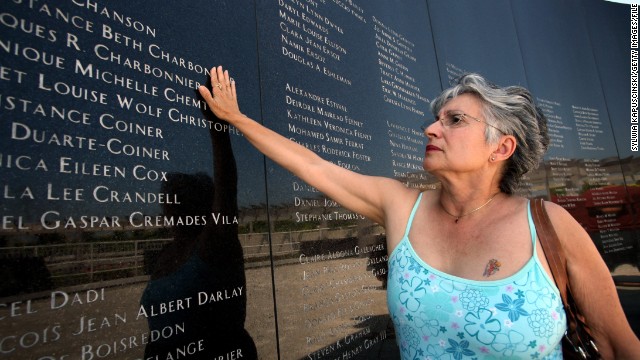 Joanne Festa touches the memorial wall commemorating the victims of TWA Flight 800 on July 16, 2006, at the Smith Point County Park in Shirley, New York.
Joanne Festa touches the memorial wall commemorating the victims of TWA Flight 800 on July 16, 2006, at the Smith Point County Park in Shirley, New York. - Accident investigators respond to critics who claim missile fire brought down the jet in 1996
- The National Transportation Safety Board blamed the crash on a fuel tank explosion
- Skeptics have asked for a new investigation and are releasing a documentary on the crash
- TWA 800 crashed into the Atlantic after taking off from New York on a flight to Paris
Ashburn, Virginia (CNN) -- More than a decade after concluding a fuel tank explosion destroyed TWA Flight 800, senior U.S. accident investigators stood their ground on Tuesday against skeptics claiming new evidence suggests missile fire downed the jumbo jet.
"I'm totally convinced there was no bomb or missile," National Transportation Safety Board investigator Jim Wildey told reporters at a briefing outside Washington.
Skeptics, including a former NTSB investigator, last month petitioned the agency to re-open its investigation and will release a documentary on the crash this month.
They said evidence suggests one or more missiles destroyed the Paris-bound Boeing 747 over the Atlantic shortly after takeoff from New York on July 17, 1996, killing all 230 on board.
The safety board has responded cautiously, saying it is having investigators who were not part of the original investigation review the petition. And it is seeking comment from Boeing, the Federal Aviation Administration, and other parties to the original probe.
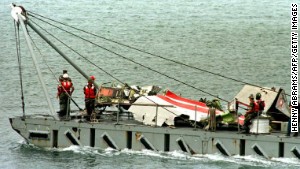 What really happened to TWA Flight 800?
What really happened to TWA Flight 800? 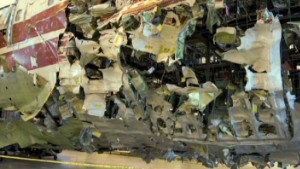 Investigator: Lies told on plane crash
Investigator: Lies told on plane crash 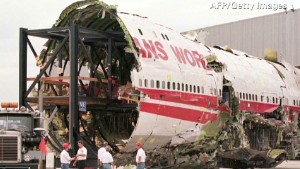 Documentary: TWA 800 crash no accident
Documentary: TWA 800 crash no accident  Ex-official: Nothing supports TWA theory
Ex-official: Nothing supports TWA theory But at the same time, the board allowed the original TWA 800 investigators to brief the media on the four-year investigation. Under orders to address only matters in the original investigation, the investigators nonetheless emphasized topics that have come under question by the critics.
They held up two sheet metal plates showing examples of bomb and high-velocity missile damage, and then took reporters to view TWA 800's reconstructed fuselage. They said they found no pitting of the type alleged by those challenging the findings.
"You don't see fragmented seat parts," said investigator Robert Swaim. Nor is there evidence of pitting, cratering or "gas jetting" -- tell-tale marks left by high explosives -- he said.
Plane reconstructed
Investigators said they were unable to find any evidence on radar of a missile intercepting the plane.
And they discounted the significance of traces of explosives found on more than 100 airplane parts pulled from the ocean.
The NTSB said tests showed that explosive residue washes off after only two days in the ocean, leading them to conclude the residue likely was the result of contamination from the military and law enforcement boats that recovered wreckage.
The NTSB allowed two TWA 800 family members to attend the briefing, and the family members reiterated their support for the board's findings.
Matt Ziemkiewicz, whose sister Jill, a 23-year-old flight attendant, was killed in the explosion, said the briefing "solidified" his belief that the original investigation was "complete, accurate and thorough."
Jim Hurd, whose son Jamie, 29, died on the flight, also endorsed the NTSB finding.
"At first I was of course skeptical as everybody else. You know, you just didn't know what happened. As things unfolded, it seemed to make a lot of sense, what happened to the plane," he said. "It's really cut and dry, at this point, as far as I'm concerned."
Ziemkiewicz and Hurd said the new attention to the crash is opening old wounds.
"It's really a shame in my book," Hurd said. "There are still family members who believe it was brought down by a bomb and I respect their thoughts and however they want to view it. It's just the way you take the information and how you process it and who you believe. And I believe the NTSB has done a job and I don't believe they've covered up anything and I don't believe the FBI did either."
The NTSB did not allow their critics into the media briefing. They talked to reporters in a parking lot outside.
'A matter of conscience'
Hank Hughes, a former NTSB investigator who now doubts the board's conclusion, said he is motivated only by a desire to uncover the truth.
Hughes said following the accident, he spent two days with Hurd.
"That's the last guy in the world I'd want to hurt," he said.
"There's no profit motive. It's a matter of conscience and integrity as far as we're concerned. Two hundred and thirty people were killed and that's a tragedy that can't be ignored," Hughes said.
Hughes is featured in the documentary, called "TWA Flight 800," co-produced by longtime skeptic Tom Stalcup.
The NTSB investigators on Tuesday repeated a scenario the safety board endorsed in 2000.
The series of events leading to TWA 800's disastrous final flight began when it was delayed at New York's John F. Kennedy airport. While the plane was sitting at the gate, the crew engaged the plane's air conditioner to keep passengers cool.
The air conditioning units, low in the plane's fuselage, heated the large, nearly empty fuel tank above it, creating a volatile fuel/air mixture.
Ten minutes after take-off, when the plane was at 13,700 feet and climbing, an electrical short that likely occurred in a wire bundle pushed a high-voltage current into the fuel tank, igniting it, and destroying the plane.
Divers found three overlapping fields of debris at the bottom of the ocean.
The first included the pieces of the fuel tank and the cabin above it. A second field contained the nose and cockpit. The final and largest debris field contained the rest of the plane.
Investigators said they worked hard to determine if a bomb or missile was involved, especially in light of the event's timing two days before the Summer Olympics and 10 days before the Olympic bombing in Atlanta.
"That really intensified the investigation," said investigator Joseph Kolly.
A cockpit voice recorder analysis showed a sound spectrum consistent with a low-explosive fuel tank explosion, not a high-explosive missile.
Eventually, investigators ruled out a missile or bomb, as well as lightning, meteor, electro-magnetic pulse, and other possible causes, Kolly said.
Kolly acknowledged some friction between the NTSB and the FBI during the investigation, but said "it didn't ultimately harm the investigation."
Kolly said the petition has not prompted him to rethink the board's 2000 findings. Since the petition was filed, Kolly said, he has re-read this report "a couple more times and it's pretty thorough."
CNN's Rene Marsh contributed to this report.







